- Home
- Garden Wildlife
- Insects
- Hymenoptera Introduction
Hymenoptera: Introduction
With at least 7,761 species recorded, the Hymenoptera is the biggest insect Order in Britain and Ireland. It is a very diverse group of insects with a wide range of structure and life styles. Common types of Hymenoptera include the sawflies, ants, bees, wasps, parasitic wasps and gall wasps. The smallest species are less than 1mm long, while the larger species are up to about 30mm. Some species are wingless, and in ants, both winged and wingless forms occur within the same species.
Hymenopterous insects undergo complete metamorphosis as they develop from egg to adult. The larval stages are very different in appearance to the adult insect and they usually occupy different habitats and have different diets. Before becoming adult, the insect will pass through a pupal stage where the adult features develop.
The Hymenoptera can be divided into three groupings, the Symphyta, and then within the suborder Apocrita or wasp-waisted hymenopterans, the groups Aculeata (stinging hymenopterans) and "Parasitica" .
The sub-order Symphyta This group contains the sawflies and woodwasps, of which there are 547 species in Britain and Ireland. They have caterpillar-like larvae that feed on plants. Most are foliage feeders but some are stem borers or develop inside fruits. The adult insects lack the narrow ‘wasp waist’ between the abdomen and thorax that is characteristic of the adult insects in the other two Hymenoptera groups. Some sawflies can be damaging pests of garden plants but most feed on wild flowers, trees, grasses, ferns and horsetails.
Wasps. Left: Solitary (Digger) wasp Ectemnius sp, More on solitary wasps here. Centre and right, the social wasp Dolichovespula media adult and its nest. Social wasps are described here.
The "Parasitica" This is an obsolete but useful term for the largest group of Hymenoptera, with more than 6,500 species in Britain and Ireland. It is also the least well studied, so it is likely that the number of known species will increase. Most Parasitica insects develop as parasitoids of insects and some other arthropod animals. The exception is gall wasps, sometimes known as cynipids, in the Cynipidae family, which develop as larvae inside plant galls, especially on oak and roses.
The parasitic wasps include ichneumonid, braconid and chalcid wasps. Some of these parasitoids are extremely small and develop as larvae inside the eggs of other insects. Others develop inside the larvae or pupae of insects, or with a few species, in the adult stage. The host animal ultimately dies when the parasitoid larva has completed its feeding. Some parasitoids are important as biological controls of garden pests, particularly aphids and whitefly in greenhouses.
Birch sawfly Cimbex femoratus Left: Adult - note the absence of a "waist", Right: the caterpillar-like larva
The clade Aculeata This major group includes ants, bees, social wasps and solitary wasps. There are 659 species in Britain and Ireland. They are characterised by the females having their egg-laying organs modified to form a sting. They are very familiar garden insects, and many are extremely important pollinators. We have several pages on these insects.
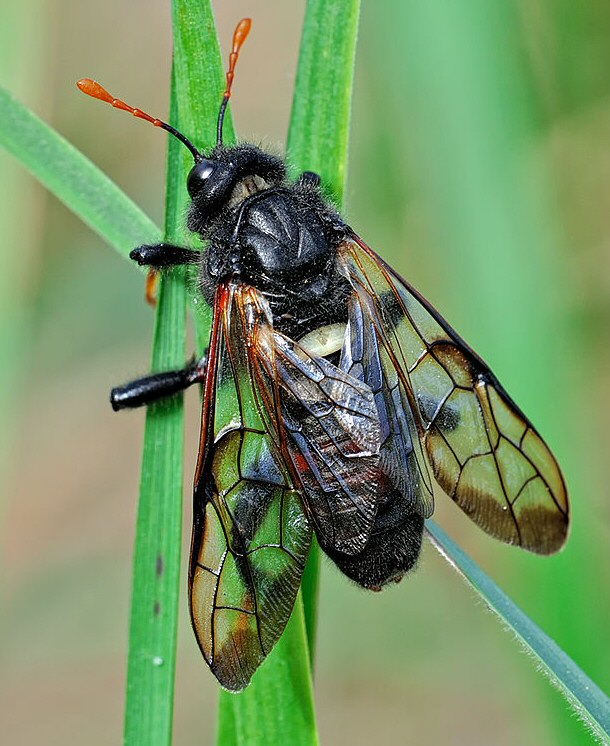
![Photo: Janet Graham [CC BY 2.0 (https://creativecommons.org/licenses/by/2.0)], via Wikimedia Commons](images/Cimbex_femoratus,_Deeside,_North_Wales,_Sept_2011_-_Flickr_-_janetgraham84.jpg)
![Photo: Fritz Geller-Grimm [CC BY-SA 3.0 (https://creativecommons.org/licenses/by-sa/3.0) or CC BY-SA 3.0 (https://creativecommons.org/licenses/by-sa/3.0)], from Wikimedia Commons](images/Lasius_Niger.jpg)
The abundant garden ant Lasius niger. Left: the winged queen - they shed their wings when they start a new colony underground. Below: a worker drinking from honey bait.
Ants are described on our page here
![Photo: Fritz Geller-Grimm [CC BY-SA 3.0 (https://creativecommons.org/licenses/by-sa/3.0) or CC BY-SA 3.0 (https://creativecommons.org/licenses/by-sa/3.0)], from Wikimedia Commons](images/Lasius_niger_fg01 queen alate.jpg)
The insects classed as bees are all adapted to collect pollen and nectar, and are evolutionarily a subgroup of the wasps. We cover Bees (Clade Anthophila) in three web pages, the bumblebees, the domesticated honeybee, and the solitary bees. They are very important pollinators.
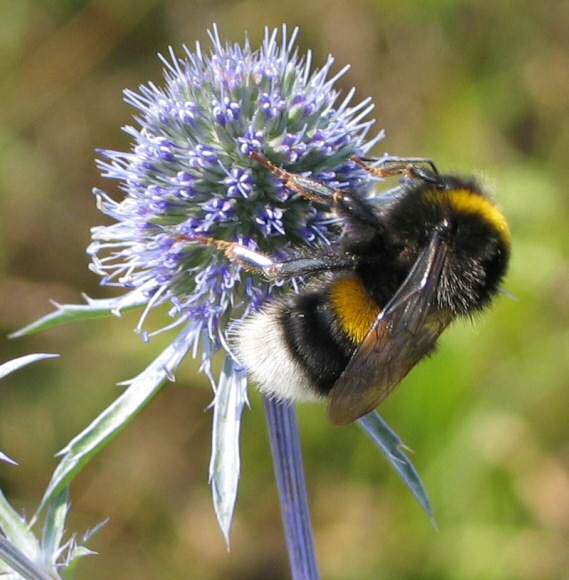
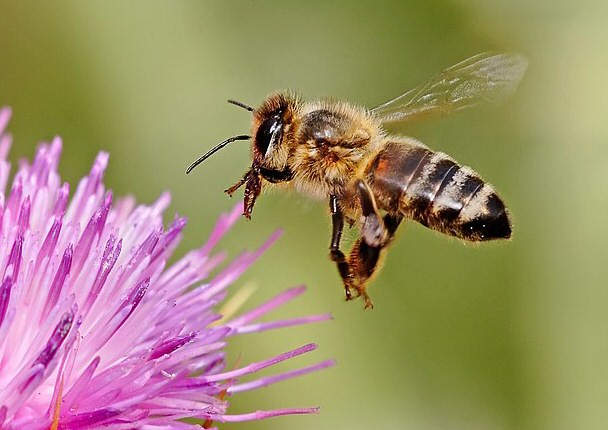
![Photo: Pjt56 [CC BY-SA 4.0 (https://creativecommons.org/licenses/by-sa/4.0)], from Wikimedia Commons](images/Andrena_fulva-pjt.jpg)
Representative bees.
Top left: the buff-tailed bumblebee Bombus terrestris Go to our bumblebee page for more.
Top right: Honeybee Apis mellifera which has its own page here.
Left: Andrena fulva the common Tawny mining bee. See our solitary bees page.
The English grouping Wasps is a "rag-bag" group, in that any aculeate hymenopteran which isn't a bee or ant is a wasp, so several not very closely related families are lumped under the English term. Most wasps are predators, but with some interesting twists, as in the "Parasitica" - see below. We have two pages on non-parasitic wasps.
![Photo: S. Rae from Scotland, UK [CC BY 2.0 (https://creativecommons.org/licenses/by/2.0)], via Wikimedia Commons](images/Digger_Wasp_(Ectemnius_sp.)_focusing_on_a_passing_hoverfly_-_Flickr_-_S._Rae.jpg)
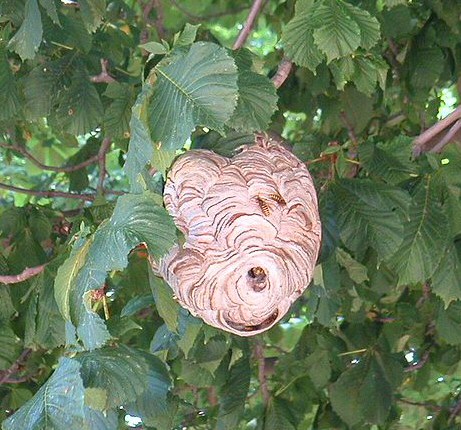
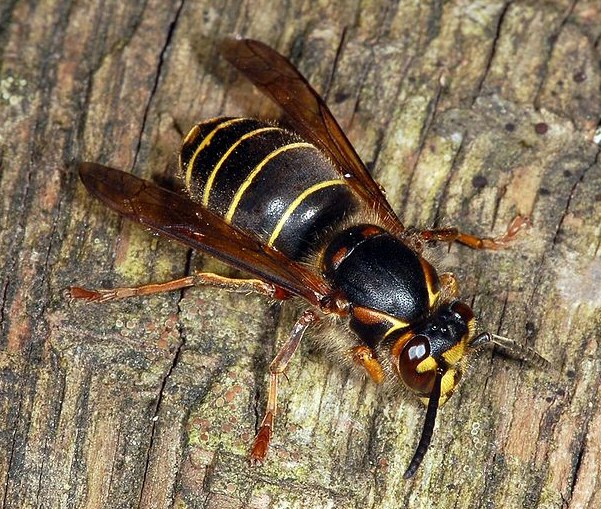
Left: Ichneumon wasp Banchus volutatorius see our parasitic wasp page for more. Centre and right: Robin's pincushion gall wasp Diplolepis rosae. Adult female, about 4mm long and the "pincushion" gall on a rosebush. We have a page on gall wasps.
Here are the further Hymenoptera pages on this website
•Ants
•Social wasps, including the hornet
Other sources of information
Websites
http://www.bwars.com Website of the Bees, Wasps and Ants Recording Society (BWARS)
http://www.britishsawflies.org.uk/ Website of British Sawflies and their survey
Books
Gauld, I. & Bolton, B. (editors) (1988) The Hymenoptera. Oxford University Press
Wilmer, P. (1985). Bees, Ants and Wasps – A key to the genera of British Aculeates. A Field Studies Council AIDGAP key
By Andrew Halstead reviewed by Andrew Salisbury edited by Steve Head
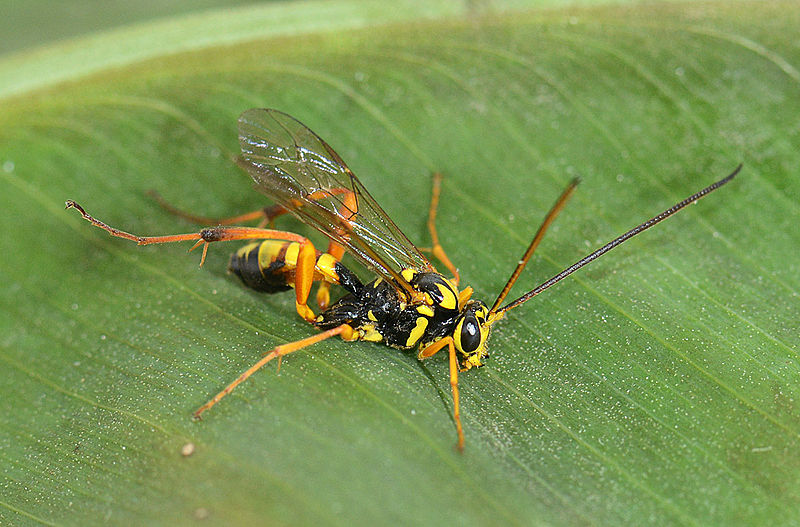
,_Arnhem,_the_Netherlands.jpg)
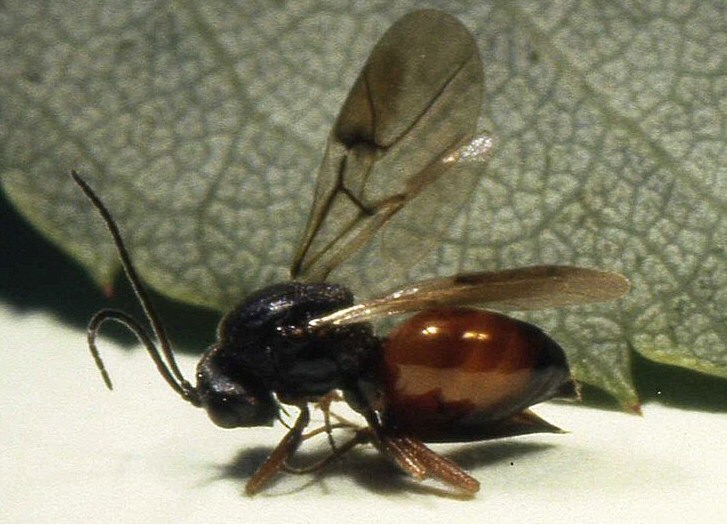
![Photo: Janet Graham [CC BY 2.0 (https://creativecommons.org/licenses/by/2.0)], via Wikimedia Commons](images/Cimbex_femoratus,_Deeside,_North_Wales,_Sept_2011_-_Flickr_-_janetgraham84.jpg)
Birch sawfly Cimbex femoratus Left: Adult - note the absence of a "waist", Right: the caterpillar-like larva
The clade Aculeata This major group includes ants, bees, social wasps and solitary wasps. There are 659 species in Britain and Ireland. They are characterised by the females having their egg-laying organs modified to form a sting. They are very familiar garden insects, and many are extremely important pollinators. We have several pages on these insects.
Hymenoptera: Introduction
With at least 7,761 species recorded, the Hymenoptera is the biggest insect Order in Britain and Ireland. It is a very diverse group of insects with a wide range of structure and life styles. Common types of Hymenoptera include the sawflies, ants, bees, wasps, parasitic wasps and gall wasps. The smallest species are less than 1mm long, while the larger species are up to about 30mm. Some species are wingless, and in ants, both winged and wingless forms occur within the same species.
Hymenopterous insects undergo complete metamorphosis as they develop from egg to adult. The larval stages are very different in appearance to the adult insect and they usually occupy different habitats and have different diets. Before becoming adult, the insect will pass through a pupal stage where the adult features develop.
The Hymenoptera can be divided into three groups:
The sub-order Symphyta This group contains the sawflies and woodwasps, of which there are 547 species in Britain and Ireland. They have caterpillar-like larvae that feed on plants. Most are foliage feeders but some are stem borers or develop inside fruits. The adult insects lack the narrow ‘wasp waist’ between the abdomen and thorax that is characteristic of the adult insects in the other two Hymenoptera groups. Some sawflies can be damaging pests of garden plants but most feed on wild flowers, trees, grasses, ferns and horsetails.

The abundant garden ant Lasius niger. Left: the winged queen - they shed their wings when they start a new colony underground. Below: a worker drinking from honey bait. Ants are described on our page here
![Photo: Fritz Geller-Grimm [CC BY-SA 3.0 (https://creativecommons.org/licenses/by-sa/3.0) or CC BY-SA 3.0 (https://creativecommons.org/licenses/by-sa/3.0)], from Wikimedia Commons](images/Lasius_Niger.jpg)
![Photo: Fritz Geller-Grimm [CC BY-SA 3.0 (https://creativecommons.org/licenses/by-sa/3.0) or CC BY-SA 3.0 (https://creativecommons.org/licenses/by-sa/3.0)], from Wikimedia Commons](images/Lasius_niger_fg01 queen alate.jpg)
The insects classed as bees are all adapted to collect pollen and nectar, and are evolutionarily a subgroup of the wasps. We cover Bees (Clade Anthophila) in three web pages, the bumblebees, the domesticated honeybee, and the solitary bees. They are very important pollinators.


![Photo: Pjt56 [CC BY-SA 4.0 (https://creativecommons.org/licenses/by-sa/4.0)], from Wikimedia Commons](images/Andrena_fulva-pjt.jpg)
Representative bees.
The English grouping Wasps is a "rag-bag" group, in that any aculeate hymenopteran which isn't a bee or ant is a wasp, so several not very closely related families are lumped under the English term. Most wasps are predators, but with some interesting twists, as in the "Parasitica" - see below. We have two pages on non-parasitic wasps.


![Photo: S. Rae from Scotland, UK [CC BY 2.0 (https://creativecommons.org/licenses/by/2.0)], via Wikimedia Commons](images/Digger_Wasp_(Ectemnius_sp.)_focusing_on_a_passing_hoverfly_-_Flickr_-_S._Rae.jpg)
Wasps. Left: Solitary (Digger) wasp Ectemnius sp, More on solitary wasps here. Centre and right, the social wasp Dolichovespula media adult and its nest. Social wasps are described here.
The "Parasitica" This is an obsolete but useful term for the largest group of Hymenoptera, with more than 6,500 species in Britain and Ireland. It is also the least well studied, so it is likely that the number of known species will increase. Most Parasitica insects develop as parasitoids of insects and some other arthropod animals. The exception is gall wasps, sometimes known as cynipids, in the Cynipidae family, which develop as larvae inside plant galls, especially on oak and roses.
The parasitic wasps include ichneumonid, braconid and chalcid wasps. Some of these parasitoids are extremely small and develop as larvae inside the eggs of other insects. Others develop inside the larvae or pupae of insects, or with a few species, in the adult stage. The host animal ultimately dies when the parasitoid larva has completed its feeding. Some parasitoids are important as biological controls of garden pests, particularly aphids and whitefly in greenhouses.

,_Arnhem,_the_Netherlands.jpg)

Left: Ichneumon wasp Banchus volutatorius see our parasitic wasp page for more. Centre and right: Robin's pincushion gall wasp Diplolepis rosae. Adult female, about 4mm long and the "pincushion" gall on a rosebush. We have a page on gall wasps.
Here are the further Hymenoptera pages on this website
•Ants
Other sources of information
Websites
http://www.bwars.com Website of the Bees, Wasps and Ants Recording Society (BWARS)
http://www.britishsawflies.org.uk/ Website of British Sawflies and their survey
Books
Gauld, I. & Bolton, B. (editors) (1988) The Hymenoptera. Oxford University Press
Wilmer, P. (1985). Bees, Ants and Wasps – A key to the genera of British Aculeates. A Field Studies Council AIDGAP key
By Andrew Halstead reviewed by Andrew Salisbury edited by Steve Head












